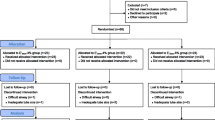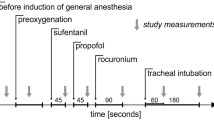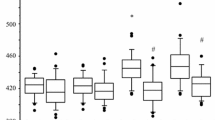Abstract
Purpose. Rapid increases in concentrations of isoflurane and desflurane in oxygen have been shown to increase sympathetic activity. The aim of this study was to determine whether concomitant administration of nitrous oxide would reduce these sympathomimetic effects of volatile anesthetics.
Methods. Eighty healthy patients in whom the trachea was intubated and mechanically ventilated were given 15 min of anesthesia with either N2O (67%)-O2-sevoflurane (GOS), O2-sevoflurane (OS), N2O (67%)-O2-isoflurane (GOI), or O2-isoflurane (OI) (n = 20 per group). The inspired concen-tration of sevoflurane was 0.85% (0.5 minimum alveolar concentration [MAC]), and that of isoflurane was 0.6% (0.5 MAC). Fifteen minutes after endotracheal intubation, baseline and arterial blood sample data were obtained. Immediately after that, a sudden administration of 2.9 MAC volatile anesthetics was performed. Systolic and diastolic arterial pressures, heart rate, and end-tidal carbon dioxide concentration were obtained at 0.5, 1, 1.5, 2, 3, 4, and 5 min after that. To measure catecholamine levels, arterial blood samples were obtained 2 and 5 min after the trial started.
Results. Except for the OI group, systolic and diastolic arterial pressure progressively decreased after the abrupt increase in the concentration of volatile anesthetics. Except for the OS group, the heart rate increased after the abrupt increase in the concentration of volatile anesthetics. In the OI group, the end-tidal concentration of carbon dioxide increased at 0.5 and 1 min, suggesting that a slight hyperdynamic state occurred. However, it decreased progressively after the abrupt increase in volatile anesthetic concentration in the other groups. Plasma norepinephrine levels increased progressively in all groups.
Conclusion. Even if nitrous oxide was added to isoflurane or sevoflurane, the increase in heart rate could not be avoided. Contrary to previous reports, severe hyperdynamic circulation was not observed after a rapid increase in isoflurane concentration.
Similar content being viewed by others
Author information
Authors and Affiliations
Additional information
Received: September 27, 1999 / Accepted: May 26, 2000
About this article
Cite this article
Wajima, Z., Inoue, T., Yoshikawa, T. et al. Changes in hemodynamic variables and catecholamine levels after rapid increase in sevoflurane or isoflurane concentration with or without nitrous oxide under endotracheal intubation. J Anesth 14, 175–179 (2000). https://doi.org/10.1007/s005400070001
Issue Date:
DOI: https://doi.org/10.1007/s005400070001




